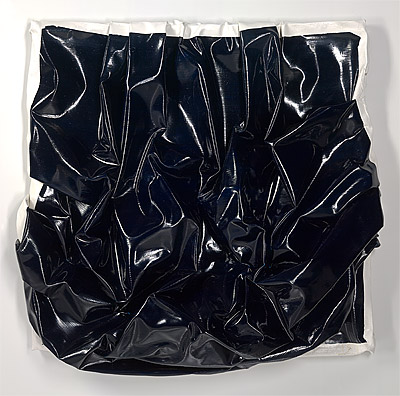Angela de la
CRUZ
Spain
1965
Loose fit (blue)
2002
oil on canvas
111.3 (h)
x 112.5 (w)
cm
National Gallery of Victoria, Melbourne
Purchased through the NGV Foundation with the assistance of Michael Buxton, Governor, and Anna Schwartz, Governor, 2003 2003.479
Angela de la Cruz’s iconoclastic approach to the history of painting turns a repertoire of destructive acts into a creative process. Loose fit (blue) 2002, for example, may have started its life as a monochromatic canvas―a work of heavily applied blue paint, neatly framed within a thick white border―but it is brutally transformed by the artist’s physical intervention. The series of punches, kicks and folds inflicted upon its surface make it into an animated sculptural object which hangs from the wall in a crumpled and dejected mess.
Loose fit (blue) looks both beaten and winded―it is, after all, the colour of new bruises; a victim of artistic bullying that celebrates the unheroic and the abject, reinstating, as a result, a connection to, and interest in, the visceral and the bodily. Defiantly anthropomorphic, the sagging folds of the work’s paint-laden canvas hang like skin on a body that has lost a dramatic amount of weight far too quickly. It is this sense of movement in de la Cruz’s fleshy surfaces―their ability to evoke the physical and emotional tension of a continual and somehow thuggish struggle―that consciously works against the clean, rarefied and self-contained ambitions of modernist abstraction. The artist’s violent and potentially cathartic practice may also be interpreted as a contemporary reworking (and, possibly, reclaiming) of the machismo of action painting. Even when these works leave the wall, and indeed their stretchers, they remain integrally connected to painterly tradition.[1] They feed off each other (many works combine the elements of previously separate canvases) but also from the lineage of painters and paintings that have come before them.
Kelly Gellatly
Curator, Contemporary Art
National Gallery of Victoria, Melbourne
[1] As do the lumpen mounds of painted canvas in de la Cruz’s Nothing series 1999

